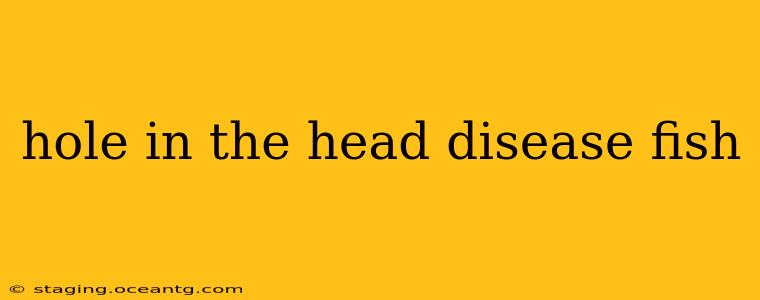Hole in the head disease (HITH), also known as Mycobacterium marinum infection, is a devastating bacterial infection affecting various freshwater and saltwater fish, particularly cichlids. This disease manifests as small, crater-like lesions on the head and body of the fish, leading to significant discomfort and ultimately, death if left untreated. Understanding the causes, symptoms, and treatment options is crucial for responsible fishkeeping.
What Causes Hole in the Head Disease?
The primary cause of hole in the head disease is bacterial infection, most commonly caused by Mycobacterium marinum. This bacterium thrives in environments with poor water quality, stress, and compromised immune systems in fish. Several factors contribute to the development of HITH:
- Poor water quality: High levels of nitrates, nitrites, and ammonia are significant stressors that weaken the fish's immune system, making them susceptible to bacterial infections like M. marinum. Insufficient water filtration and infrequent water changes directly contribute to this problem.
- Stress: Stressful situations, including overcrowding, aggressive tank mates, improper handling, and sudden changes in water parameters (temperature, pH), can suppress a fish's immune response, increasing vulnerability to HITH.
- Nutritional deficiencies: A diet lacking essential vitamins and minerals weakens the fish's immune system, making them more susceptible to disease.
- Injury: Pre-existing injuries or abrasions on the fish's body can provide entry points for M. marinum bacteria.
- Introduction of infected fish: Introducing a new fish to the tank without proper quarantine can introduce the bacteria and spread the disease rapidly.
What are the Symptoms of Hole in the Head Disease?
Recognizing the early symptoms of HITH is crucial for effective treatment. Initial signs often include:
- Small, shallow pits or lesions: These typically appear on the head and face of the fish, often around the eyes and mouth. They may start as small, white spots and gradually enlarge, forming crater-like holes.
- Loss of appetite: Fish with HITH often show a reduced interest in food.
- Lethargy and listlessness: Infected fish may appear less active and spend more time resting at the bottom of the tank.
- Weight loss: As the disease progresses, fish may experience significant weight loss due to reduced food intake and the body's effort to fight the infection.
- Skin discoloration: The skin around the lesions may become reddened or inflamed.
How do I tell the difference between Hole in the Head Disease and other fish diseases?
Differentiating HITH from other diseases requiring similar treatment is crucial for effective treatment. Many infections show similar symptoms initially, so professional diagnosis is important. This is especially true for distinguishing HITH from other bacterial infections or parasitic infestations that require different approaches. Visual inspection often is insufficient to make a definitive diagnosis; water quality testing and a thorough examination by a veterinarian specializing in aquatic animals are recommended.
Can hole in the head disease be cured?
While a cure isn't always guaranteed, early detection and prompt treatment significantly improve the chances of recovery. The severity of the infection, the fish's overall health, and the effectiveness of the treatment all contribute to the success rate.
How is Hole in the Head Disease Treated?
Treatment for HITH typically involves a multifaceted approach:
- Improve water quality: Regular water changes (25-50% weekly) are crucial to reduce the bacterial load in the tank. Ensure proper filtration and maintain stable water parameters.
- Medications: Several medications, including antibiotics (often requiring a prescription from a veterinarian), can help combat the bacterial infection. Follow the veterinarian's instructions carefully regarding dosage and duration of treatment.
- Quarantine: Isolate infected fish from healthy ones to prevent the spread of the disease.
- Diet modification: Provide a high-quality diet rich in vitamins and minerals to support the fish's immune system.
- Stress reduction: Minimize stress factors by ensuring appropriate tank size, suitable tank mates, and stable environmental conditions.
What are some preventative measures for Hole in the Head Disease?
Preventing HITH is far easier than treating it. Proactive measures include:
- Quarantine new fish: Always quarantine new fish for several weeks before introducing them to your main tank.
- Maintain excellent water quality: Regular water changes, proper filtration, and monitoring of water parameters are essential.
- Provide a balanced diet: Offer a varied diet rich in vitamins and minerals.
- Minimize stress: Avoid overcrowding, aggressive tank mates, and sudden environmental changes.
Hole in the head disease is a serious condition requiring prompt attention. By understanding the causes, symptoms, and treatment options, fishkeepers can take proactive steps to protect their fish and maintain a healthy aquarium environment. Remember to consult with a veterinarian experienced in aquatic animal care for accurate diagnosis and personalized treatment plans.
